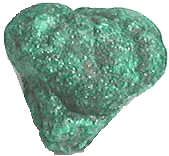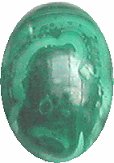
 |
In focus: Malachite |
| Chemical Composition: Cu2CO3(OH)2 | |
| Group: Carbonate | |
| Colour: Green, Dark green, Blackish green | |
| Streak: light green | |
| Hardness: 3.5-4 | |
| Density: 3.9-4 | |
| Luster: Vitreous | |
| Cleavage: Perfect x1 | |
| Heat sensitive: yes | |
| Acid sensitive: yes | |
|
Malachite (a Copper Carbonate Hydroxide) is a famous semi-precious stone. The stone's name comes (via Latin and French) from the Greek molochitis, "mallow-green stone", from molochē, variant of malachē, "mallow". Its banded light and dark green layers are so characteristic that malachite is easily recognized, even by non-specialists. The beautiful green of Malachite has been known for millenia. It was mined by ancient civilizations, and when ground to a powder it was used as a pigment. There is evidence that malachite was used to colour paint in Egypt as early as 4000 BC. |

Malachite is typically associated with copper deposits within limestones (limestone being the source of the carbon in Malachite). The Malachite is created during the weathering of copper deposits, although the exact process is still not fully understood. In addition, Malachite is often associated with almost all secondary copper minerals including limonite, chalcopyrite, bornite, native copper, calcite, cuprite, azurite as well as more rare minerals: kolwezite, shattuckite, antlerite, brochantite, graemite, aurichalcite, sphaerocobaltite, atacamite, chalcophyllite, conichalcite, rosasite, chalcosiderite, clinoclase, cornetite, duftite, libethenite, liroconite, mixite and mottramite chrysocolla.
Malachite is most abundant in its massive carvable forms - and some beautiful statues have been made using this stone. The crystalline forms are much rarer and have only recently become widely available to the mineral collector. Large quantities of malachite are been mined in the Urals, but the mineral is found world-wide including the Democratic Republic of Congo, Tsumeb, Namibia, Russia, Mexico, Broken Hill, New South Wales, England, Lyon; and in the United States especially in Arizona at Bisbee and Morenci.
Because of its close association with other secondary copper minerals, Malachite can create so-called pseudomorphs, the best known being the azurite pseudomorph. A pseudomorph is when the chemical composition of one mineral is replaced with another mineral, but the mineral retains its original shape. So in the case of a malachite-azurite pseudomorph the mineral may have a perfect azurite crystal shape but still be a malachite.
In additon, malachite also has it's own "impostor", also known as pseudomalachite. Pseudomalachite is a copper phosphate (Cu5(PO4)2(OH)4) that resembles malachite in both colour and the massive crystal habitat, but the chemical composition and the structure are different. It also lacks the characteristic light and dark green banding of malachite. Like malachite, it forms in the oxidation zone of copper ore deposits, but it is much rarer.
Today malachite can be made synthetically under the laboratory conditions. What is needed is:
| _______________________________ | ||||
| Home | | | Shopping | | | Database |
© Biscuit Software 2004-2015
All rights reserved